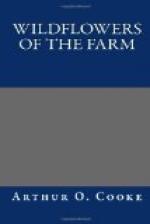Here is a blossom from which the calyx has just dropped. The four large scarlet petals, two of which are slightly larger than the other two, have lain inside all crumpled up—not neatly folded as is the case with most flowers. Yet in a very short time after the calyx has dropped off, the sap will flow into the petals and will smooth them out. They will be as glossy, smooth, and shining as the other blossoms fully open on the plant.
The brilliant Poppy is more beautiful than useful—to the farmer and the bees at any rate. Most flowers contain nectar, but the Poppy has none at all. If the bees come to it, it is for the dusty yellow pollen to make into wax.
The seed pods of some flowers open when ripe, and the seeds fall out. In others the pod or case does not open but rots away. The Poppy has a different way of scattering its seed. There is a ring of tiny holes in the seed case, and through these holes the seed is shaken out. The leaves are long, but vary a good deal in size and shape. The stems are covered with stiff and bristly hairs.
CHAPTER X
IN THE CORN-FIELD (continued)
Besides the poppies there is Charlock in the field; not much, Mr. Hammond will be glad to know, for he has been trying for many years to get rid of this plant altogether. Pretty as the yellow blossoms of the Charlock are, it is one of the most troublesome weeds which the farmer has to fight. It is only an annual certainly, and each seed-pod holds no more than six or seven seeds. The seeds, however, are oily, and this oiliness preserves them. If they are ploughed deep into the ground, they may live there for several years, and will produce a plant when turned up again by the plough or the scuffle.
Mr. Hammond tells me that some years ago this field was full of Charlock, and in the early summer there would be more Charlock than wheat to be seen. This is how he got rid of it. Every year he ploughed the field and got it ready for the crop as early as possible. Then the Charlock sprang up before the crop of corn or turnips was sown; thus it could be rooted out. Still, as we see to-day, there is a little left, though it is growing less each year.
Charlock is wild mustard. There is more seed than blossom here to-day, for the flowering time for Charlock is in June. If we chew some seed from a pod, we shall find it hot and biting to the tongue. In some parts of England many farmers grow mustard as one of their crops.
Near Willow Farm some farmers grow mustard as a catch-crop. They sow it in autumn, as soon as another crop has been taken off the field. In the spring it is eaten by sheep, or else it is ploughed in. A catch-crop ploughed in like this enriches the land. Moreover a number of weeds are buried with the catch-crop before they have time to blossom and to shed their seed.




